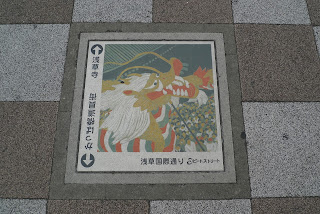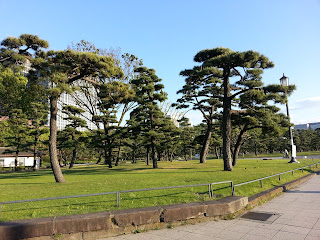Wedenesday
Breakfast @ hotel in Osaka
Now that I am sorting out the photos, I find that some of them has been lost in transmission.. like the vast JR Station where we took the bullet train to Tokyo. The journey took around 3 hours and it was quiet and relaxing train ride...there was no loud talking and everyone was doing his own thing.
On arrival at Tokyo station, the guide was already waiting for us, another Malaysian who has been residing in Tokyo for the past 10 years!.
As it was lunchtime, we requested for Ramen and he took us to a Ramen shop nearby our hotel. This looked a everyday local Ramen shop.
Tonkotsu ramen... so creamy and delicious
After lunch, we walked to the hotel for checking in and along way we saw these pretty manhole covers.
You are reminded not to smoke along the roads. In Japan there are special designated smoking areas. And in Japan there are a lot of "Do Not" rules without any mention of penalty to be paid if you break them and strangely most of the Japanese just follow the rules!
This is a "koban", the local police box at the street corner where you not only can report of theft or robbery but where you can also ask for directions where you want to go...
such a homely corner outside the hotel reception area. We were staying again at the Toyoko Inn near Asakusa area.
This Japanese decoration is called "Kumade". These bamboo rakes are decorative good luck charms which the Japanese put up on new year day "to rake up or sweep in" good luck and prosperity for the coming year. Such a "homely" hotel. I am not sure whether I have mentioned before, but at these Toyoko Inns, they do provide free pyjamas shirts! You just need to take from the cupboard at the lobby.
After checking, it's a free and easy day for us to wander around the area.
this is a wall mural inside the train station
mural inside another train station.
this alley leads towards the Asakusa Temple, not far from our hotel.
by evening, we can see these mobile street foodstall (Yatai) being set up along the roadside. These are casual places for after-work drinking and eating.
The Tokyo Train Station Building, one of the busiest train station where all the Shinkansen high speed (bullet trains) lines, the regional Japan railways and also the Tokyo Metro are located as well.
The construction of the a central station for the new railway for construction the Shinbashi and Ueno districts began in 1914 at the site in front of the Imperial Palace. The station was named Tokyo Station.
Under the dome are 8 statues of eagles positioned in the octagonal corners while on the walls are 8 Zodiac sculptures( the blue colour circle) in the corners eg rat (in the north corner), rabbit (east) Horse (South) and Rooster (West)
the exterior red bricks walls
The Marounchi Building was completed in 1923 and was the largest office building in Japan during the pre-WW II period.

This area around the train station is the Marounchi area, where the old building and the new skyscrapers stand side by side.
From the central of the Tokyo Station, we walked across towards the outer grounds of the Imperial Castle.
Beautiful sculptured trees.. and it was so windy and we felt cold even though the sun is shining.
so much open space and a long walk towards the Imperial Palace
The deep moat that surrounds the Imperial Palace aka Tokyo Castle where the Japanese Imperial family resides. You need to book in advance for guided tour to the inner palace grounds or the Imperial East Garden.
Meganebashi (spectacle or Eyeglass) bridge
There are actually 2 main bridge entrances bridges to the Imperial Palace ie the stone entrance bridge which is this one and behind is another iron bridge. Hence it is known as Nijubashi (double bridge). The stone bridge's twin arches appear like a pair of eye-glass in the reflection of the moat and we can only view this from a distance.




























The manhole cover is sure different from ours here.
ReplyDeleteTrue, something to take photos with.
ReplyDelete